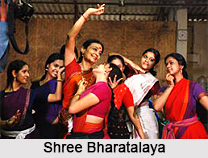 Padmashree Dr. Sudharani Raghupathy, at Shree Bharatalaya teaches Nalini Bharatanatyam. At the tender age of 10, she had her arangetram (graduation performance ) and ever since, she has been playacting at some of the most authoritative centres of the country. She has also performed at the Museum Theatre for Max Muller Bhavan apart from her performances at all the reputed sabhas. She performed at Max Muller Bhavan as a tribute to the International Year of the Child.
Padmashree Dr. Sudharani Raghupathy, at Shree Bharatalaya teaches Nalini Bharatanatyam. At the tender age of 10, she had her arangetram (graduation performance ) and ever since, she has been playacting at some of the most authoritative centres of the country. She has also performed at the Museum Theatre for Max Muller Bhavan apart from her performances at all the reputed sabhas. She performed at Max Muller Bhavan as a tribute to the International Year of the Child.
In the popular television series "Bharatanjali", Nalini took part. Her guru Sudharani Raghupathy conducted the series. Her other noteworthy performances are: the Natyanjali Festival held at Chidambaram, at the Murugan Temple in Porur and the Siddhi Vinayakar Temple in Madras. The Tamil Nadu Iyel Isai Nataka Mandaram also awarded her four programmes at Karaikudi, Neyvelli, Pollachi and Karur.
In the year 1982, the Government of India Scholarship for Bharatanatyam was given to Nalini Prakash. The prestigious Kalamandir scholarship was also conferred to her in the year 1986. From Queen Mary`s College, Madras Nalini graduated in the year 1985, in Indian Music, Philosophy and Culture. During her tenure in college, she was adjudged as the best dancer for 3 consecutive years. She took part in a dance drama during her days in the college. Dr. Padma Subramaniam choreographed the Drama for the post Centenary celebrations of Madras University. Nalini Prakash was given one of the main roles in the Drama. In the year 1987, she completed her Masters in Performing Arts with distinction from the M.S.University at Baroda.
Shree Bharatalaya at their Silver Jubilee celebrations conferred the award, the Bharatha Kala Bhushana to Nalini Prakash. Nalini Prakash was the ex- student of Shree Bharatalaya. Under Padma Shree Madurai N.Krishnan and Prof. S.Ramanathan, Nalini received her training in music. Nalini presently lives at Conoor. In the name of Silambam, she runs a dance school that is also a branch of Shree Bharathalaya of which she was an ex student. It was mainly to create awareness among the younger generation and to make them interested in Bharatanatyam.
Nalini has also served as the Secretary of the Bharatiya Vidya Bhavan, Nilgiris Kendra. As an advocator of the arts, Nalini for the past 4 years has been conforming to programs in educational institutions for SPICMACAY in the Nilgiris. Nalini is a bachelor`s degree holder in Carnatic music and a master`s degree holder in Performing Arts (Bharatanatyam).



















